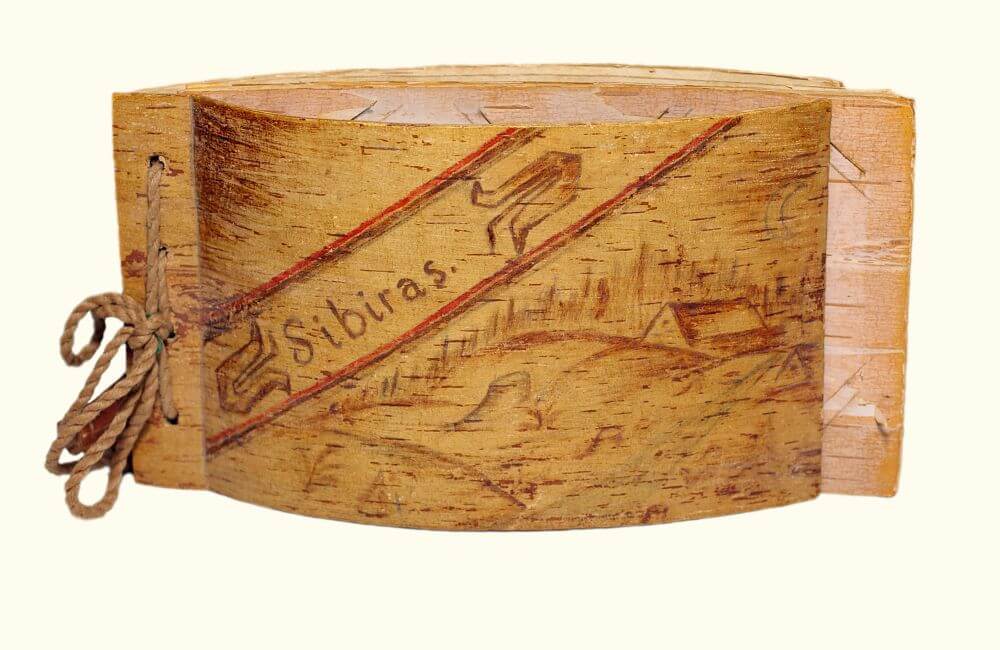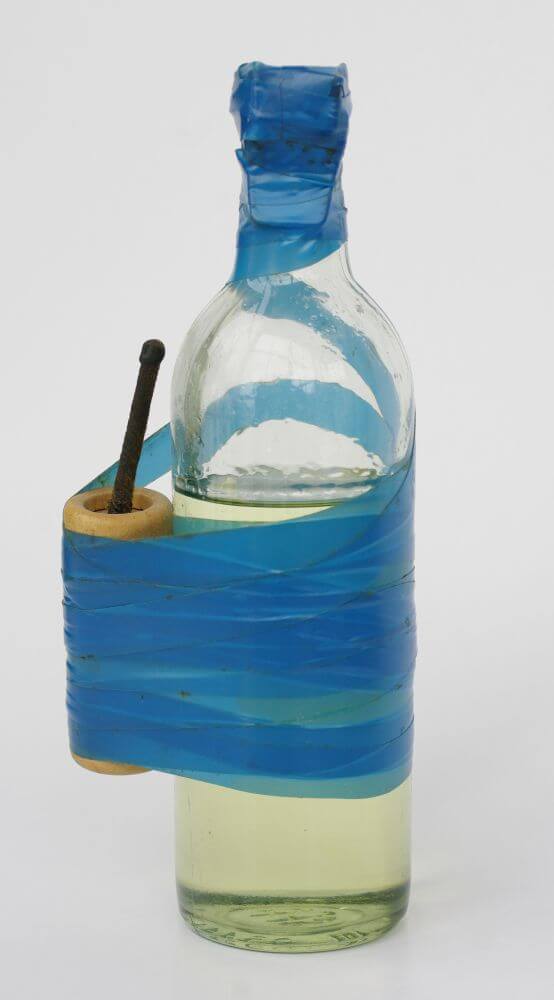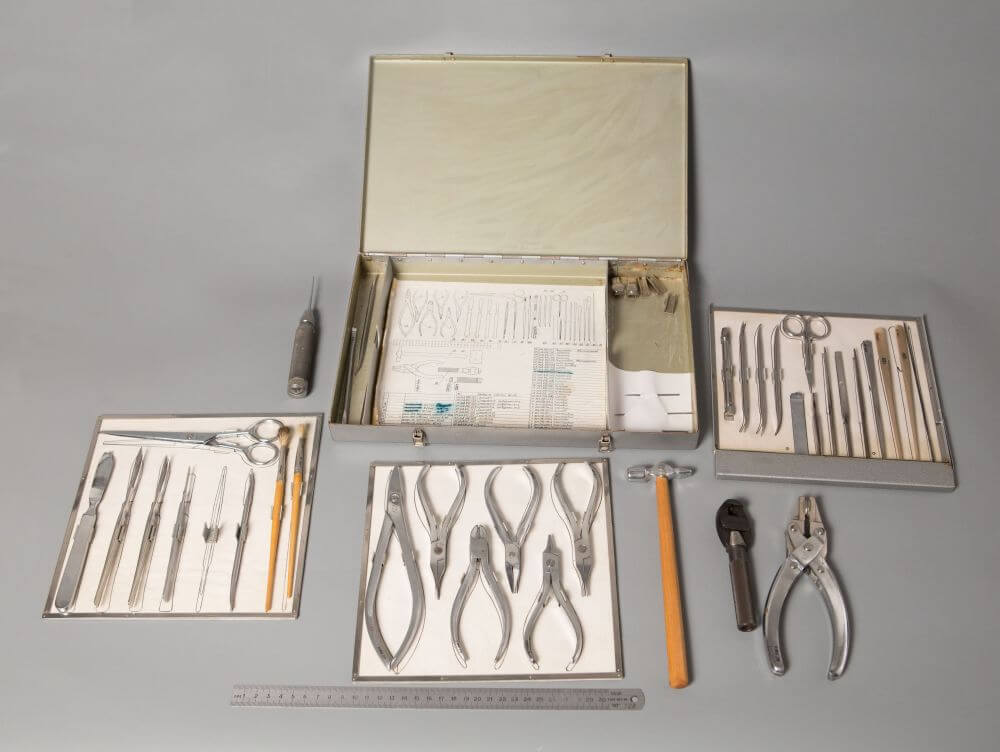The aim of the Museum of Occupations and Freedom Fights is to collect, preserve, study, and promote historical documentary material reflecting the policies, ideology, and repressions of the Soviet and Nazi occupation authorities against the Lithuanian population. The Museum pursues this goal by assembling the following collections: Independent Lithuania, Lithuanian population in prisons and exile, Armed anti-Soviet resistance, Unarmed anti-Soviet resistance, Operations of Soviet repressive agencies. The above-mentioned funds contain more than 144,000 items of photography, writings, documents, and objects. The number of exhibits is supplemented annually by new items.
Based on the material collected in the funds, the Museum staff organises permanent and temporary expositions, virtual and travelling exhibitions, educational programmes, publications, etc. Every year, several hundred digital images of the Museum’s exhibits are selected and made available to researchers, students, authors of books, scholarly papers, exhibitions, Museum displays, and educational projects from Lithuania and abroad. In this way, the Museum’s exhibits are publicised and disseminated.
1. INDEPENDENT LITHUANIA
When the Museum was established in 1992 in the former KGB building of the LSSR, photographs of officers of the Independent Lithuanian Armed Forces were found among the extensive documentary material left behind by the Soviet security services. However, it was not originally intended to form a separate collection of Independent Lithuania. Later, when individuals began to donate photographs of the interwar period to the Museum and knowing that many Lithuanian officers had been subject to repressions and participated in the partisan resistance against the Soviet invaders, it was decided to start a new collection of documents on the period of independent Lithuania.

Photographs form the largest group of items in this collection. One of the first items to be added to the collection were photographs of the funeral of the legendary Lithuanian pilots Steponas Darius and Stasys Girėnas in Kaunas. The collection has amassed photographs of Lithuanian politicians and statesmen, Lithuanian army leadership, military services – infantry, cavalry, artillery, military aviation, military officers, and officers who later became future leaders of the partisan warfare, and military equipment donated by individuals and purchased by the Museum. A collection of photographs belonging to the Lithuanian military figure, Colonel Konstantinas Dulksnys of the General Staff, and a unique photo album of the staff of Kaunas Fortress VI and the military prison that was there. The collection includes photographs of repressed prominent Lithuanian clergymen and works by interwar photographers who recorded people and their lives in Lithuanian cities and towns.
The number of exhibits assigned to Writings is not large. These include a collection of coats of arms of Lithuanian towns and cities drawn by artist, archaeologist, and Museum staff Tadas Daugirdas, postcards, prayer books, and holy pictures used as promotion materials or dedicated to national and religious festivals and other commemorative dates.

The group of documents includes passports of Lithuanian citizens, personal certificates, birth certificates of residents, study books of students of higher education institutions, certificates, service sheets of the Lithuanian Armed Forces, and pilot logbooks.
The collection of Objects contains exhibits belonging to this group: clothes of Lithuanian politicians and statesmen, state awards, badges of the Riflemen’s Union, a sculpture of the national symbol of Vytis, paintings.
2. LITHUANIAN POPULATION IN PRISONS AND EXILE
The collection is based on historical material handed over to the Museum by survivors of deportations or imprisonment in the Soviet Union’s forced labour camps and prisons, or by their relatives, collected during expeditions, or acquired by the Museum. The collection consists of photographs, writings, documents and objects belonging to the category of Objects. The collection regularly receives new exhibits. The Museum undertakes to preserve the objects handed over to it and, if necessary, to restore or conserve them. The most important task is to maximise the utilisation of the incoming artefacts by using them in the Museum’s exhibitions, travelling and virtual exhibitions, publications, and by depositing them with other Museums.
The bulk of the collection consists of individual photographs and albums. They show the everyday life of deportees or political prisoners: the nature of exile and imprisonment sites, the panorama of settlements, moments of work and leisure, the joys of weddings and christenings, funeral processions; the barbed fence enclosing the territory of the labour camp, the humble interior of the barracks, the work crews, the rich leisure time of the political prisoners under conditions of constrained freedom. The photographs of the 1941 deportees from the Komi ASSR, Novosibirsk and Tomsk oblasts, the Altai krai, and the Yakutia ASSR are particularly valuable and rare. The photographs reflect the survivors’ desire not only to survive, but also to preserve the family’s cultural, national and religious traditions.

The collection of writings includes diaries, letters, homemade postcards, collections of poems and songs, homemade prayer books, drawings from exile, labour camps, and prisons. Particularly valuable are diaries, letters written in wagons while still in Lithuania and reaching relatives, as well as letters on birch bark, usually sent by the prisoner in the labour camp to his family in exile. In 2015, the latter were included in the Lithuanian National Register of the UNESCO Memory of the World Programme.

The collection of documents consists of a group of personal documents: temporary identity cards (issued in exile instead of a passport), workbooks and character references, educational graduation documents, letters of commendation, bread cards and food vouchers, medical certificates, certificates of release from exile or the camp, tickets for traveling home, and letters from various institutions prohibiting or restricting the ability of former deportees and political prisoners to register, obtain employment, or attend school.

The collection of objects consists of a group of authentic, mostly homemade items. They can be classified into several categories: relics of work, household, leisure, religious ceremonies, and historical memory. They range from axe, planer, saw, fishing nets, sewing machines and needles; household objects from birch wood utensils to metal spoons and graters; from crocheted curtains and tablecloths to meticulously embroidered wall runners and tiny napkins; from souvenir boxes for letters, combs and mirrors decorated with national symbols to travel trunks; from a rosary made from bread in a prison cell or a greeting card embroidered with a fish bone, called a visiting card, to the liturgical vessels for holy mass ceremonies from felt and batting to a tomb cross or a plaque with the number of a dead prisoner stamped on it.
3. ARMED ANTI-SOVIET RESISTANCE
The collection only began to be built up after the establishment of the Museum. It is based on historical documentary material found in the central KGB palace in Vilnius. These are documents, photographs, publications confiscated from partisans, associates, or supporters by the security services, which were not included in the criminal files, apparently because they were no longer needed to prove the guilt of the defendants. Some of this material was categorised by the security services, others were stored in a fragmentary manner. The collection was expanded with Museum objects donated by the population, discovered during expeditions, purchased, found during archaeological excavations, and donated by other organisations. The collection is grouped into exhibits: photographs, writings, documents, objects.

The stories of Lithuania’s partisan war against the Soviet invaders are inextricably linked with the photographs depicting these struggles. They photographs form a significant part of the collection. They feature freedom fighters, liaisons, and supporters of all the partisan districts that operated in Lithuania. They show partisan rallies, congresses, award ceremonies, everyday life, housing, leisure time and farewells to friends in arms. A unique exhibit of the collection is a photo album, which was presented to Adolfas Ramanauskas-Vanagas in 1950 by the partisans of Tauras District.

Unfortunately, photographs of partisans quite often ended up in the hands of Soviet security. Most of them were found in the former KGB central palace in Vilnius – the so-called evidence room and library. The security officials carefully numbered people in the photographs, and the interrogators, while torturing the detainees, did their utmost to extract the names and nicknames of the captured fighters and names of their relatives. To this end, they compiled a filing system of partisan photographs, some of which have been preserved in the Museum. The collection contains images of the cruel fate of Lithuanian freedom fighters – images of dead and desecrated partisans. This behaviour was intended to discourage the Lithuanian population from resisting the occupation regime. The desecration of bodies had another purpose: the security services sought to find out the relatives of the dead partisans, and those who acted as liaisons with the anti-Soviet underground.

The Lithuanian Freedom Fighters continued the traditions of the Lithuanian army, and therefore acted as a military organisation, regulating their activities by documents. This is evidenced by the partisans’ orders, reports, letters, patriotic duty sheets, acknowledgements, awards, etc., stored in the collection. The documents confirm the fact that the underground structure of partisan activity covered almost the whole of Lithuania. A unified military administration of partisan rule was gradually being formed from individual units, which was named in 1949 the Movement of the Struggle for Freedom of Lithuania (LLKS). This organisation issued its own statutes, economic and judicial regulations, intelligence instructions, and drafted partisan award ceremonies and issued insignia. The documents record the reality of Lithuanian freedom fighters: the battles fought, the partisans who distinguished themselves in the battles, human life losses, appointments of officers, the formation or disbanding of organisational units, the life of partisans, and interpersonal problems. Particularly valuable in the collection are the archives of partisan documents from Algimantas, Kęstutis, Prisikėlimas and Tauras districts.

The most valuable group of exhibits is made up of elements of partisan uniforms: authentic armbands, ties, and homemade hat badges. An important part of the collection is made up of artefacts found during expeditions, as well as archaeological finds from excavations in partisan bunkers. The archaeological finds can be divided into several categories: elements of armaments, details of uniforms with national symbols, partisan household and personal hygiene items, cultural and religious objects. The collection contains reconnaissance equipment of the West paratrooper groups: generators, radios, transmitters, receivers, etc.

The group of written artefacts includes partisan manifestos, appeals to the population, newspapers, collections of poetry, songs, memoirs, and partisan written pieces. The Museum holds notebooks with handwritten memoirs of partisan leader Adolfas Ramanauskas-Vanagas, the diary of Prisikėlimas District partisan Andrius Žemaitis, and written works of partisans about battles and perished friends. Partisan satirical publications and cartoons, which freedom fighters used to brighten up their everyday life, are a colourful part of the collection. The press collection consists of more than thirty titles of newspapers and magazines, as well as non-periodicals.
4. UNARMED ANTI-SOVIET RESISTANCE
The collection is based on material confiscated by the KGB during the Soviet era from dissidents or citizens who sympathised with them: books, underground publications, documents. The collection is expanded regularly.
The group of documents contains statements and appeals written by underground organisations to the government of the Soviet Union and various international organisations. One of the more interesting exhibits is a thick bound petition of Lithuanian Catholics calling for the return of the nationalised Klaipėda St. Mary’s Queen of Peace Church, signed by 143,869 of the faithful. This request, sent in 1979 to Leonid Brezhnev, Chairman of the Presidium of the Supreme Council of the USSR, ended up in the KGB drawers. Another large part of this group is made up of certificates of KGB employees on confiscated underground press.

In the group of photos, the majority constitute moments captured with a camera from the period of the national revival movement. Some of them were taken by KGB agents who would record unsanctioned gatherings, the first Sąjūdis rallies. Without getting involved in the dispersal of the rally participants, KGB agents would take pictures of the participants and record their speeches. In some of the photographs, rally participants were numbered and identified by the KGB agents. Most of the photographs reflecting the unarmed resistance of 1950’s-1980’s was acquired from participants.

The group of objects is small but very diverse. It contains personal belongings of unarmed resistance fighters, national symbols confiscated by the KGB, typewriters, other prohibited items, posters, and banners used at rallies in 1988-1990, weapons and personal memorabilia of parliamentary defenders.
The largest group in the collection is made of writings. Most of it consists of underground periodicals and other literature confiscated from dissidents or their sympathisers during the Soviet period. Currently, the Museum holds more than 3,000 pieces of underground periodicals alone: almost all issues of the Chronicle of the Catholic Church of Lithuania, underground magazines and newspapers such as Aušra, Vytis, Rūpintojėlis, Alma Mater, Dievas ir Tėvynė, Tiesos kelias, and others. A separate part of the group consists of non-periodical underground publications that were disseminated in Lithuania in 1960’s-1980’s.

The collection contains both original and translated underground texts of various genres (from poetry and fiction to social, religious and ethical studies) and scope (from single leaflets to pamphlets and books). They have been produced and reproduced by a variety of means: typewritten, copied by various duplicating machines, reproduced by improvised machines, rephotographed, and even printed on typographic devices. The collection also contains personal archives of members of the Lithuanian Freedom League, the Helsinki Group, the Baltic Appeal, and the Sąjūdis initiative group, which are rich in photographic, written and documentary material.
The archives of organisations also make up a significant part of the Museum’s funds – audio recordings of Lithuanian radio broadcasts from 1990-1991, documents and photographs of the Klaipėda Sąjūdis initiative group, and rally and press archives from the period of the revival movement.
5. SOVIET REPRESSIVE AGENCIES
The collection reflecting operations of the Soviet repressive institutions consists mainly of objects, photographs, documents, and books found in the KGB building in 1992. Valuable artefacts were found in the former Museum of Chekists’ Glory, the premises of the Operational Technical Department, the special library, the photo laboratory, and the offices of KGB employees. The exhibits have been transferred to the Museum by the Lithuanian Special Archive, private individuals, some have been purchased. The collection consists of the following groups of exhibits: documents, writings, photographs, and objects.
The group of documents and writing exhibits consists of various service certificates of KGB employees, event and concession permits. There are also incomplete civil registration documents – birth certificates, which could have been used by KGB employees or agents to create legends. A rather large part of this group of this collection consists of KGB printing press products: forms, permits, files, folders, letters of appreciation, and commemorative postcards with the Committee’s symbols. The collection contains a variety of KGB-issued educational literature, individual and periodical publications that introduced Soviet security officials to the topical issues of their work in those days and analysed intelligence and counterintelligence issues.
The exhibits in the group of photos are from the former Museum of Chekist Glory. They depict KGB leaders, ordinary officers, awards of “outstanding” Chekists, celebrations and everyday life of the security service agents. The collection also includes diagrams of the structures of partisan formations and various anti-Soviet organisations, plans of operations organised by the Chekists, and educational photo albums on the subtleties of camouflage and the use of special equipment by KGB officers. The collection is supplemented by photographs of the repressive structures in Lithuania and the reality of the Soviet era.
The most interesting part of the group of artefacts is the partially preserved inventory in the KGB building. This includes the equipment of the telephone wiretapping room: operator consoles, tape recorders, headphones, central distribution cabinet; the equipment of the photo laboratory: portable photocopying devices, microfilm reviewing equipment, enlargers. There is also a considerable amount of equipment from other security offices: desks, cabinets, chairs, safes, ideological portraits, coats of arms of the USSR and the LSSR, typewriters, telephones, desk lamps, etc. The collection contains a collection of photographs of the KGB Deputy Minister, Gen. A. Gailevičius’ uniform and uniform of the KGB officers and soldiers in 1980’s. There is a large collection of stamps for cabinets, safes, and postal parcels. Interesting equipment from the Operational Technical Division used for the installation of ‘bugs’ for secret surveillance, for screening postal parcels and other purposes.














